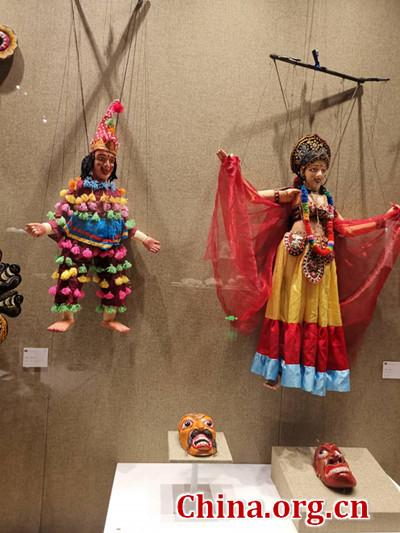Craftsmanship highlights Asian cultural diversity
- By Wu Jin
 0 Comment(s)
0 Comment(s) Print
Print E-mail China.org.cn, May 17, 2019
E-mail China.org.cn, May 17, 2019

Holding a plier, Raed Al Badri is cutting an array of stone slabs into smaller, equally-sized cubes and sticking them onto a paper drawing of a tree.
"This is the 'Tree of Life,' very famous in Jordan," he said, while sitting behind a desk in the No.3 Hall of the National Library of China in Beijing, where a "Craftsmanship of Civilization Exhibition of Intangible Cultural Heritage in Asia" opened on May 16.
Following a visit to Yinchuan, capital of Ningxia Hui Autonomous Region in northwest China, four years ago, this is Badri's second trip to China and also the first to Beijing. The genre of his handcraft is called "Stone Mosaic," a very popular ornament made from differently-colored stones collected from different areas in Jordan.
As chairperson of the Jordan Handicraft Producers Association (JHPA), Badri was invited by the Chinese side to participate in the exhibition and demonstrate the unique art form on spot to coincide with Beijing's hosting of the week-long Conference on Dialogue of Asian Civilizations (CDAC) from May 15.
"I Like China," Badri said. "I believe we have something special that we can exchange between a small country like Jordan and China."
He is correct. Over the past few years, China has been making joint efforts with various parts of Asia and beyond to revive the trade routes explored more than two millennia ago by ancient land caravans and seagoing navigators. In doing so, it hopes the exchanges along the ancient routes can thrive again in modern society.
The exhibition involving 30 artists from 14 Asian countries, including, Turkey, Iran and South Korea, displays a range of 310 artistic works, like, large-scale pieces of embroidery, porcelain and mahogany furniture from China, puppets from Indonesia, Buddha statue from Nepal, eggshell carvings from Kuwait and oil paintings from Vietnam.
Speaking at the opening ceremony of the exhibition, Li Jinsheng, chairman of the board of China Arts and Entertainment Group Ltd., said: "As one of the series of programs echoing CDAC, the exhibition is expected to demonstrate the diversity of ancient Asian civilizations by indigenous intangible cultural heritages that well define the region's unique and profound historic legacies.
"Every artwork here is exquisitely designed, definitely reflect the Asian spirit as well as Asian people's aspirations for a better life. Therefore, the exhibition will stimulate us to conduct even more insightful studies on Asian civilizations and boost our confidence in Asian culture."
From the tidy and meticulous stitching of brocade which can trick people at first sight into believing they are seeing large oil paintings, to the Khon Mask in striking colors from Thailand, Korean traditional hats that symbolize conventional social classes and official rankings to neatly-etched Japanese pottery and from China's old libraries following the principle of simplicity to a Vietnamese painting of a tranquil riverside life, the exhibition is full of memory-evoking longstanding culture.
Qiu Zhijie, professor from Central Academy of Fine Arts, said: "When porcelain and other pottery headed north and the camel bells tinkled across vast westward-heading routes thousands of years ago, the interconnection we now honor along the Silk Road and Maritime Silk Road had an impact not only on how exquisitely the articles were produced, but also on the way in which aesthetic values were appreciated.
"From imperial courts to ordinary households and from libraries to fields, the fragrance of tea pervaded Asian territory and cultivated an elegant lifestyle concentrated on inner peace," said Qiu while expounding the age-old Asian characteristics.

He is not the only one who had a strong feeling for the conventional Asian cultural legacies.
Didik Nini Thowok, an Indonesian artist said: "As a part of Asia bearing cultural both tangible and intangible heritage, we will partake in advancing Asia's rich craftsmanship and diverse civilizations. Together we all will make bigger contribution to maintain, to enrich and to conserve world civilizations.
"The acculturation among these diverse cultures has been connecting us, one to another. It is now our will and our effort to save such splendid cultural achievements in our civilizations for the future generations."
The exhibition augurs well for a promising future as it offers people an opportunity to realize the ancient bonds enhanced by trade and exchanges across Asia.
Jia Junliang, a retired Beijinger, commented: "I have rarely gone abroad. Therefore, I would like to take this chance to get a glimpse of different civilizations of China's neighboring countries, where the cultures, in my view, should share some similarities."
Meanwhile, Fan Di'an, chief curator of the exhibition and president of the Central Academy of Fine Arts, explained: "[We held the exhibition] not only focus on how we can reproduce the utensils of conventional craftsmanship, but, more importantly, on how we can revive the spirit, the elegance and the style of the particular cultures [that first produced them]."
The exhibition is hosted by China Arts and Entertainment Group Ltd, Central Academy of Fine Arts and National Library of China and organized by China International Exhibition Agency and Beijing Tangying Culture Communication Co Ltd.






Go to Forum >>0 Comment(s)